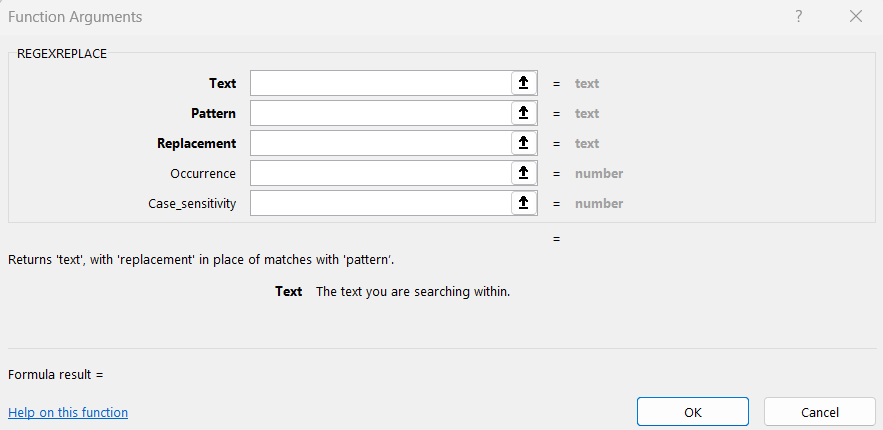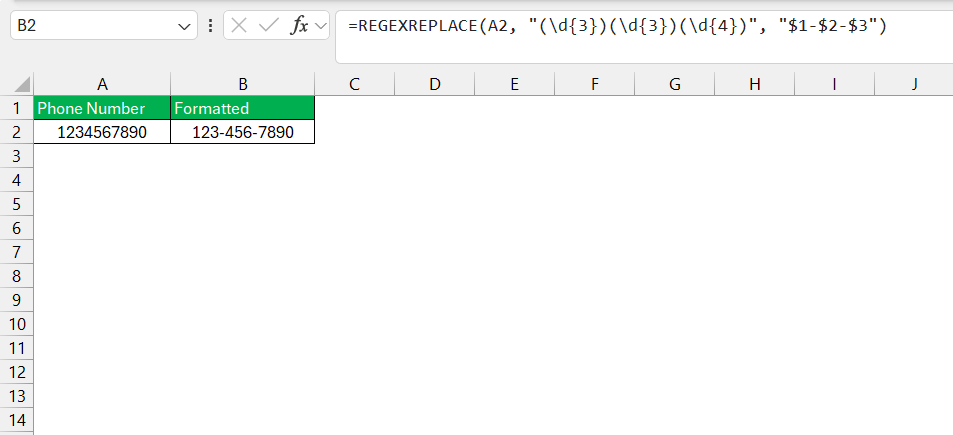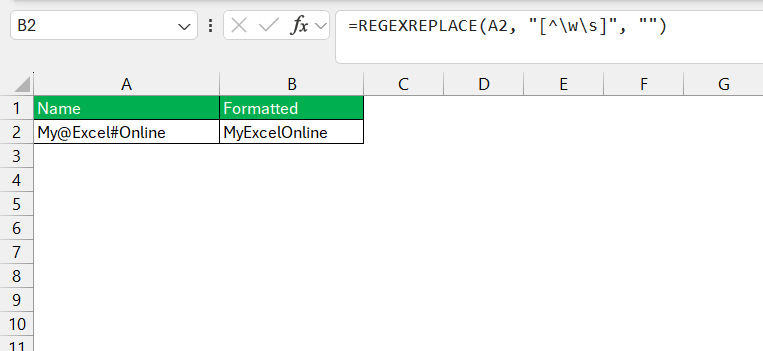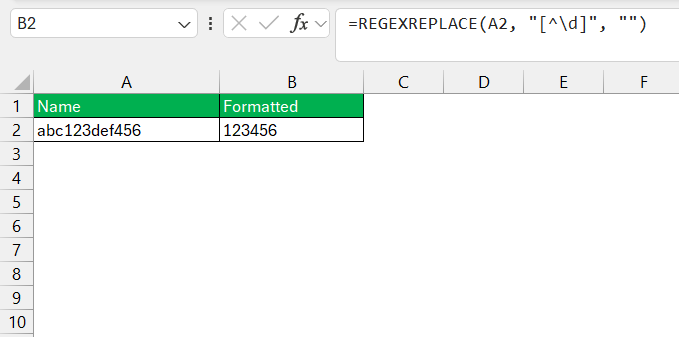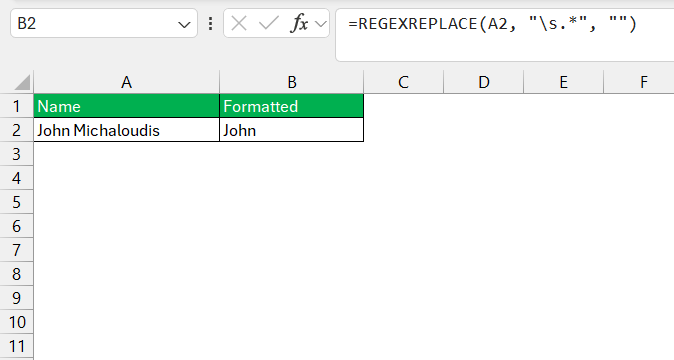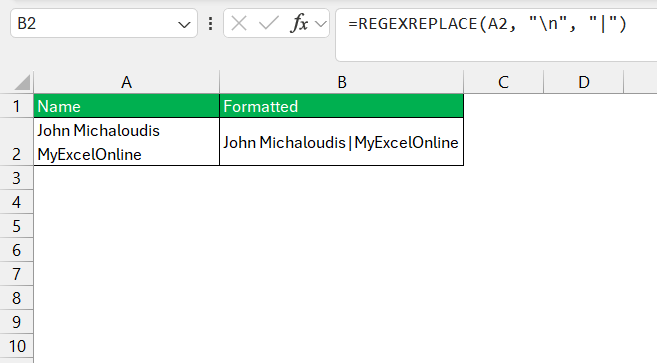If you’re dealing with complex patterns, regex (short for regular expressions) can be a powerful tool to manipulate and transform text efficiently. One regex function I find particularly useful is REGEXREPLACE, which helps with complex text replacement tasks. In this article, I’ll walk you through how to use REGEXREPLACE in Excel to perform powerful text manipulations.
Key Takeaways:
- Regex is powerful for text manipulation – It allows you to search, match, and replace text based on complex patterns in Excel.
- REGEXREPLACE goes beyond basic replacements – It helps standardize formats, remove unwanted characters, or extract specific data.
- Common regex symbols – Symbols like
\d,\s, and\wrepresent digits, spaces, and word characters, respectively. - Practical uses – You can format phone numbers, remove special characters, extract digits, or replace line breaks.
- Troubleshooting Regex – Test patterns often, simplify complex patterns, and use Excel functions alongside Regex for better results.
Table of Contents
Mastering RegexReplace in Excel
What Is Regex and Why Use It in Excel?
Regular expressions, often abbreviated as Regex, are sequences of characters that form a search pattern. These search patterns are extremely handy for textual analysis and manipulation. In Excel, Regex takes the form of functions that allow us to search, match, and replace parts of the text based on defined patterns.
It’s a powerful tool for those looking to clean data, validate text entries, or format strings within spreadsheet cells quickly and consistently. By using Regex in Excel, we save precious time and reduce the potential for human error in handling large datasets.
Here are some common regex patterns:
\d– Matches any digit.\w– Matches any word character (alphanumeric + underscore).\s– Matches any whitespace character..– Matches any single character except for a newline.*– Matches zero or more of the preceding element.+– Matches one or more of the preceding element.^– Matches the start of a string.$– Matches the end of a string.
Setting the Stage for Advanced Text Manipulation
Before diving deep into Regex, it’s critical to lay a sturdy foundation for advanced text manipulations in Excel. This involves understanding when and why native functions like FIND or REPLACE might not suffice. Imagine scenarios with inconsistent data entries or complex patterns like email addresses, dates in various formats, or mixed alphanumeric strings.
These are instances where Regex shines, as it can discern patterns beyond the basic functions’ capabilities. Additionally, preparing your workbook by enabling Regex functions and ensuring you’re familiar with the syntax and modifiers will set the stage for more sophisticated text manipulation tasks
Essential Regex Functions for Excel Users
Understanding the REGEXREPLACE Function
REGEXREPLACE allows me to search for a specific pattern in a string (using regex) and replace it with another string. This goes beyond the basic text replacement functions in Excel because I can use more complex patterns for finding the text I want to change.
The syntax for REGEXREPLACE is:
=REGEXREPLACE(text, pattern, replacement)
where:
- text is the input string.
- pattern is the regex pattern that defines what I want to find.
- replacement is the string that will replace what’s found.
The REGEXREPLACE function is a game-changer for anyone working with text in Excel. Essentially, it finds text in a cell that matches a specified regex pattern and replaces it with something else. For instance, if I’m dealing with a column of inconsistent phone number formats and want to standardize them, REGEXREPLACE can format these phone numbers neatly with a pattern I define.
Navigating Other Key Regex Functions – REGEXEXTRACT and REGEXMATCH
Alongside REGEXREPLACE, there are other key regex functions in Excel that prove incredibly useful: REGEXEXTRACT and REGEXMATCH. REGEXEXTRACT pulls specific data from a string by finding the parts that match a regex pattern.
For example, extracting email addresses from a mixed list of contact information becomes a breeze. REGEXMATCH, on the other hand, checks if part of a text matches a regex pattern and often returns TRUE or FALSE, which is perfect for data validation and conditional formatting scenarios. Together, these tools form a powerful trio, enabling users to test, extract, and modify data efficiently.
Practical Applications of Regex in Excel
Formatting Phone Numbers
Let’s say I have phone numbers without formatting like 1234567890 and I want to add dashes to make them look like 123-456-7890. Here’s how I’d use REGEXREPLACE for that:
=REGEXREPLACE(A2, “(\d{3})(\d{3})(\d{4})”, “$1-$2-$3”)
This groups the digits and inserts dashes at the right places.
Removing Special Characters
If I have a list of names and I want to remove any special characters like @, #, or $, I can apply this regex pattern:
=REGEXREPLACE(A2, “[^\w\s]”, “”)
This will remove all non-word characters, leaving just letters and spaces.
Extract Digits Only
If you have a string with both letters and numbers and you want to keep only the digits, use:
=REGEXREPLACE(A2, “[^\d]”, “”)
- Pattern: [^\d] matches any character that is not a digit.
- Replacement: “” removes those characters.
For example, if A2 contains “abc123def456”, this will return “123456”.
Extract the First Word
If you want to extract just the first word from a string (assuming words are separated by spaces), use:
=REGEXREPLACE(A2, “\s.*”, “”)
- Pattern:
\s.*matches any space followed by any characters (everything after the first word). - Replacement:
""removes those characters, leaving only the first word.
For example, if A2 contains "John Michaloudis", this will return "John".
Replace Line Breaks with a Space
If you have text that contains line breaks, and you want to replace them with spaces, use:
=REGEXREPLACE(A2, “\n”, “|”)
- Pattern:
\nmatches newline characters. - Replacement: replaces with
"|".
For example, if A2 contains "John Michaloudis\nMyExcelOnline", this will return "John Michaloudis|MyExcelOnline".
Tips for Maximizing Efficiency with Excel Regex
Best Practices for Writing Regex Patterns
When we talk about best practices for writing Regex patterns, the emphasis is on efficiency and readability. Start simple and test often. Make sure your pattern accomplishes its task with the least complexity necessary, to save processing time and maintain clarity. It’s also best to use non-capturing groups unless you need to use the captured data.
Comment your patterns to explain what each part does, which is invaluable for future editing or when sharing your spreadsheets with others. Avoiding ‘greedy’ quantifiers that match as much as possible can help prevent unexpected results, especially when using the wildcard character. In doing so, we strike a balance between powerful functionality and manageable, error-free code.
Troubleshooting Common Regex Pitfalls in Excel
In troubleshooting common Regex pitfalls in Excel, it pays to be both meticulous and patient. A common issue faced by many users is the ‘zero matches’ problem, where your Regex does not match anything even when you expect it to. Double-check your pattern for syntax errors or misplaced quantifiers, as these are often the culprits.
Another pitfall is overly complex expressions which can lead to slower performance and harder-to-find errors. Always break down complex patterns into smaller, more manageable pieces for testing. Don’t forget to use Excel’s own functions alongside Regex where appropriate. For instance, TRIM can handle excess whitespace before involving Regex. Remember, Regex is powerful, but it’s not a silver bullet—understanding when and how to use it is key to avoiding common issues.
FAQ: Regular Expressions in Excel
How to regex replace in Excel?
To perform a regex replace in Excel, you’ll utilize the REGEXREPLACE function. You simply enter the cell you want to change, the regex pattern for the text to find, and the text to use as the replacement. For example, to change multiple spaces to a single one in cell A1, you’d use =REGEXREPLACE(A1, "\s+", " "). Just remember that regular expressions must follow a specific syntax, and the REGEXREPLACE function is currently available in Excel for Microsoft 365 users.
How do I get started with Regex Replace in Excel?
Getting started with Regex Replace in Excel is as simple as learning the basic Regex syntax and functions. Start by familiarizing yourself with the REGEXREPLACE function. Then, practice with simple patterns, like replacing spaces or removing special characters, to build up your confidence. Make sure you have the latest version of Excel, as Regex functionality might not be available in older versions. Online tutorials, practice exercises, and communities can also provide guidance and support as you learn.
Can Regex be used for complex text manipulations in Excel?
Absolutely, Regex can be used for complex text manipulations in Excel, handling tasks that go far beyond the capabilities of standard Excel functions. Regex allows you to define intricate search patterns that can match, extract, and replace text based on almost any criteria you can think of. It’s especially powerful for tasks like data sanitization, parsing structured data formats, or preparing data for analysis. With a solid understanding of Regex syntax and functions, you can transform bulky, unruly data into clean, useful information.
What are some common mistakes to avoid when using Regex in Excel?
Some common mistakes to avoid when using Regex in Excel include not accounting for all possible variations of the pattern you’re trying to match, which can lead to missed or incorrect matches. Using overly complex or overly broad patterns can cause performance issues or unexpected results. Not testing your regex patterns on a sample of your data can also be a pitfall, as it’s crucial to ensure they work as intended before applying them to your entire dataset. Lastly, forgetting special characters need to be escaped in regex patterns is a common oversight that can cause errors in your formulas.
Are there any good resources for learning advanced Regex functions?
Yes, there are several excellent resources for learning advanced Regex functions. Online platforms such as Udemy and Coursera offer comprehensive courses tailored for different levels of expertise. Websites dedicated to programming, like freeCodeCamp and Codecademy, also provide tutorials that include Regex. Moreover, the community-driven website Stack Overflow is an invaluable resource for real-world problems and solutions. Books like “Mastering Regular Expressions” by Jeffrey Friedl can be great for in-depth learning. Plus, joining Excel forums and communities provides an opportunity for hands-on problem solving and networking with other learners.
John Michaloudis is a former accountant and finance analyst at General Electric, a Microsoft MVP since 2020, an Amazon #1 bestselling author of 4 Microsoft Excel books and teacher of Microsoft Excel & Office over at his flagship MyExcelOnline Academy Online Course.

